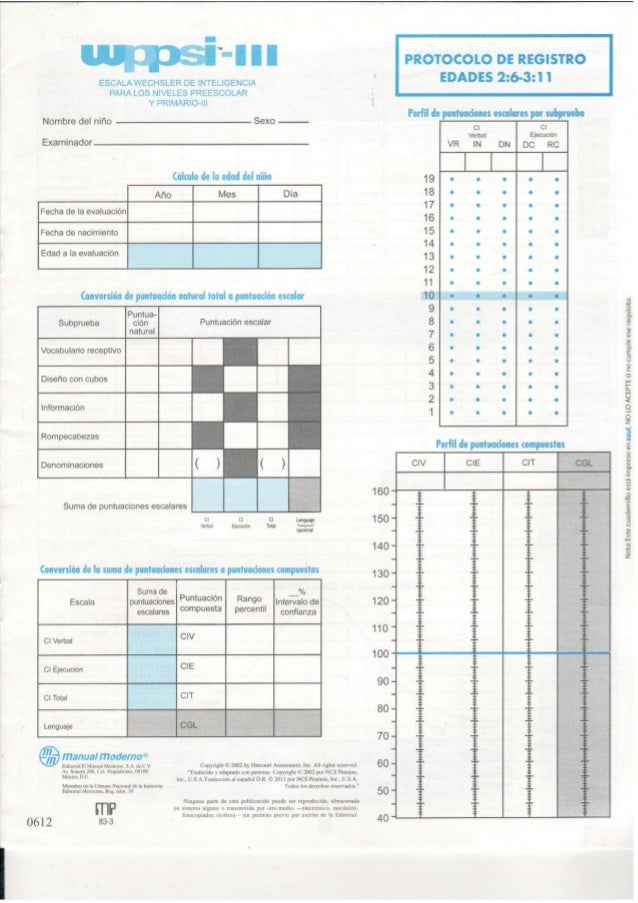Wais Iv Manual Pdf
Team fortress 2 download steam. Frequently Asked Questions.
For WAIS–IV and WMS–IV Introduction Advanced Clinical Solutions for WAIS–IV and WMS–IV (ACS) is an individually. WAIS–IV and WMS–IV. The Clinical and Interpretive Manual is included with the ACS Software and contains a description of the rationale behind the development of the various tasks contained within. Manual Mexico.pdf - Free ebook download as PDF File (.pdf) or read book online for free. Scribd is the world's largest social reading and publishing site.
- Dear WAIS–IV Customer, We want to bring to your attention a change we have made to the WAIS–IV Technical and Interpretive Manual, Table C.2: Differences Between the FSIQ and the GAI Required for Statistical Significance. The formula previously used to calculate these values did not account for.
- Outcome Measure Wechsler Adult Intelligence Scale - IV (WAIS-IV) Sensitivity to Change Yes Population Adult Domain Neuropsychological Impairment Type of Measure Objective test ICF-Code/s b1 Description The current version of the test, the WAIS-IV, which was released in 2008, is composed of 10 core subtests and five supplemental subtests, with the.

The WAIS-IV (2008) is the latest revision of the adult Wechsler battery. The addition of new, and deletion of old tests, plus a more-factor based foundation. 5.1 WAIS-IV technical manual, p. 62) As per common EFA factor analysis methods, inspection of eigenvalue scree plot. Title: Wechsler Adult Intelligence Scale Fourth Edition (WAIS-IV) Created Date: 5/16/2008 4:34:35 PM. Outcome Measure Wechsler Adult Intelligence Scale - IV (WAIS-IV) Sensitivity to Change Yes Population Adult Domain Neuropsychological Impairment Type of Measure Objective test ICF-Code/s b1 Description The current version of the test, the WAIS-IV, which was released in 2008, is composed of 10 core subtests and five supplemental subtests, with the.
User Manual
Appendix C
and other cognitive functions. The GAI does not replace the FSIQ, but it should be reported and interpreted along with the FSIQ and all index scores, including the WMI and PSI.
When to Use the GAI The impact of neuropsychological problems related to working memory and/or processing speed deficiencies is evident in Table C.4, which shows that FSIQ < GAI discrepancies were obtained by more than 65% of the examinees in the following WAIS–IV special group samples: Intellectual Disability-Mild Severity, Intellectual Disability-Moderate Severity, Borderline Intellectual Functioning, ADHD, TBI, Autistic Disorder, Asperger’s Disorder, and Probable Dementia of the Alzheimer’s Type-Mild Severity. In these situations, the reduction in the FSIQ related to working memory and/or processing speed difficulties may complicate contextual interpretation of performance on other tests, such as measures of memory, executive function, or achievement. When assessing an examinee who presents with potential neuropsychological issues, the GAI may be useful to clarify interpretation. For example, if the referral question involves memory impairment, the GAI may be less sensitive to age-related cognitive decline than the FSIQ. The forthcoming WMS–IV Technical and Interpretive Manual (Wechsler, in press) will provide information regarding the use of ability-memory comparisons using the GAI. The use of the WISC–IV GAI in educational settings has been discussed in Raiford et al., 2005. The WAIS–IV GAI may be used similarly to the WISC–IV GAI, as permitted by local and state education agencies. Tables C.5–C.9 are provided for use in ability-achievement discrepancy comparisons between the WAIS–IV GAI and the WIAT–II. For other examinees with working memory and/or processing speed difficulties, it also may be clinically informative to evaluate the reduced impact of these abilities on an estimate of general cognitive ability by comparing the FSIQ and the GAI. This comparison may inform rehabilitation programs and/or educational intervention planning. More information about interpretation of such comparisons is available in Saklofske, Weiss, Raiford, and Prifitera (2006). The practitioner may wish to consider using the GAI in a number of clinical situations, not limited to, but including the following: 쮿 a significant and unusual discrepancy exists between VCI and WMI, 쮿 a significant and unusual discrepancy exists between PRI and PSI, 쮿 a significant and unusual discrepancy exists between WMI and PSI, or 쮿 a significant and unusual subtest discrepancy between subtests within WMI and/or PSI. To evaluate index score discrepancies, refer to chapter 2 and Tables B.1 and B.2 in the Administration and Scoring Manual. The Analysis page of the Record Form provides space for pairwise discrepancy comparisons in the Discrepancy Comparison table. A statistically significant difference between index scores, however, may not indicate that there is a clinically significant difference: The frequency of occurrence in the normative sample (base rate), not just the critical value, should be considered. Use Table B.2 to obtain the base rate for a given discrepancy. Sattler (2008a) suggests that any statistically significant difference is potentially meaningful and that differences between scores that occur in less than 15% of the normative sample should be judged as unusual. Tables B.3 and B.4 provide critical values and base rate information for the subtest-level pairwise comparisons related to the WMI and PSI (i.e., Digit Span–Arithmetic and Symbol Search–Coding).
167
WAIS4_TIM_FNL7
170
Appendix C
Step 3. Perform the FSIQ–GAI Discrepancy Comparison To perform the FSIQ–GAI discrepancy comparison, calculate the difference between the FSIQ and the GAI by subtracting the GAI score from the FSIQ score, remembering to note if the resulting value is positive or negative. Record this value. Table C.2 provides the required differences between the FSIQ and the GAI to attain statistical significance (critical values) at the .15 and .05 levels for each age group. Using Table C.2, find the examinee’s age group and the desired level of significance. Read across the row to the appropriate column to determine the critical value, and record this value. Determine whether or not the absolute value of the examinee’s difference score equals or exceeds the corresponding critical value. The absolute value of the examinee’s difference score must equal or exceed that critical value to be statistically significant. Table C.2
Differences Between the FSIQ and the GAI Required for Statistical Significance (Critical Values), by Age Group and Overall Normative Sample Age Group 16–17 18–19 20–24 25–29 30–34 35–44 45–54 55–64 65–69 70–74 75–79 80–84 85–90 All Ages
Level of Significance
Critical Value
.15
2.91
.05
3.96
.15
2.51
.05
3.41
.15
2.57
.05
3.50
.15
2.58
.05
3.51
.15
2.71
.05
3.68
.15
2.69
.05
3.66
.15
2.41
.05
3.29
.15
2.58
.05
3.51
.15
2.26
.05
3.08
.15
2.65
.05
3.61
.15
2.45
.05
3.34
.15
2.35
.05
3.19
.15
2.52
.05
3.44
.15
2.56
.05
3.48
Note. The differences required for statistical significance (critical values) are calculated with the following formula derived based on the logic of Davis (1959) Case 1, Equation [3].
∑ SEM i ( SEM Xi )( SEM Xj ) ∑ SEM 2j 2
Critical Value of Difference Score = Z SEM Xi2 + SEM Xj2 − 2
where Z is the normal curve value associated with the desired two-tailed significance level, SEM Xi and SEM Xj are the standard errors of measurement for the GAI and FSIQ composite scores, 兺SEM 2i is the sum of the squared standard errors of measurement for all subtests in the GAI, and 兺SEM 2j is the sum of the squared standard errors of measurement for all subtests in the FSIQ.
WAIS4_TIM_FNL7
Appendix C
In some situations, practitioners may wish to determine how unusual the same or greater FSIQ–GAI discrepancy was in a particular special group sample. Table C.4 provides cumulative percentages (base rates) of obtained FSIQ–GAI discrepancies for the 13 special group samples described in chapter 5. To determine how rare or common the examinee’s difference score is relative to a special group of interest, use Table C.4 and locate the absolute value of the examinee’s difference score in the Amount of Discrepancy column to the extreme left or right. Read across the row to the column that corresponds to the special group of interest and the direction of the difference score (e.g., FSIQ < GAI). Record this value, remembering to note that this particular base rate pertains to a special group sample rather than to the normative sample.
173
WAIS-IV
Diane L. Coalson, .. Lawrence G. Weiss, in WAIS-IV Clinical Use and Interpretation, 2010
Wais Iv Manual Moderno Pdf
Publisher Summary
Manual Wais Iv Version Chilena Pdf

Descargar Manual Wais Iv Pdf
The Wechsler Adult Intelligence Scale—Fourth Edition (WAIS-IV) is the latest revision of Wechsler's adult intelligence scales, the most widely used tests of intelligence for adults. It represents a continuing tradition of change and innovation that has been most evident in recent revisions of the scale. This chapter provides an overview of the scale's historical and contemporary foundations. The Wechsler Adult Intelligence Scale—Fourth Edition reflects the culmination of over 70 years of progressive revisions to the Wechsler line of adult intelligence measures. Wechsler's foresight in defining intelligence in practical terms has allowed the very flexibility needed for ongoing revisions to his intelligence scales in light of advances in theory, research, and the measurement of intelligence. The most recent editions of the Wechsler intelligence scales have involved dramatic changes based on burgeoning research advances in neuropsychology, cognitive neuroscience, and contemporary intelligence theory, as well as increasing sophistication in psychological measurement. Despite these substantial innovations, some critics perpetuate the myth that the Wechsler intelligence scales are outdated or atheoretical. This chapter elaborates on Wechsler's views about intelligence and the progressive adaptations to his intelligence scales in light of contemporary theory and research.